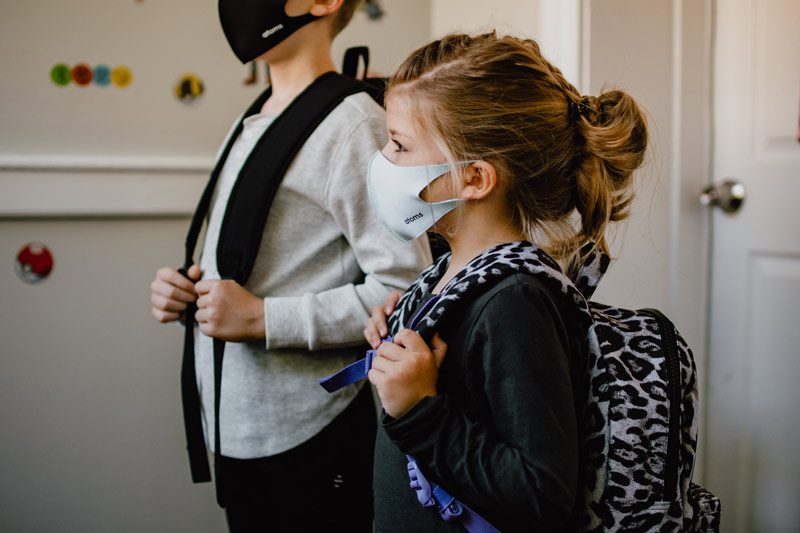Shopping for school supplies and new clothes used to get kids excited to go back to school. Now they may dread the idea of sitting in a classroom all day because they’ve adjusted to virtual learning. Ongoing COVID-19 concerns can make returning to school seem scary.
No one should walk into school with a cloud of dread hanging over them. Parents and teachers can learn how to help kids transition back to the physical classroom while managing mental health concerns about going back to in-person learning.
1. Focus on the Positives
Everyone’s listened to depressing, heartbreaking, and fear-inducing news stories since the pandemic began. Kids are no exception, even if they don’t regularly sit down to watch the reports. They hear about case counts and hospitalizations from their parents or friends, so they’re understandably nervous about going back to in-person classes.
Parents can talk about the good memories their kids made in school before the pandemic. Mention book fairs, field days, and musical performances your child once loved. Emphasize how they can make those memories all over again by leaving online learning in the past. Kids will feel better once they have something to look forward to.
2. Identify Anxiety-Driven Behaviors
Back-to-school anxiety can cause particular behaviors or moods that indicate when a child is scared or upset. They might start chewing their nails or skipping meals. Some people with anxiety can’t sleep or sit still for very long. Parents and teachers can look for these behaviors and talk with the kids who exhibit them. Discuss how everyone can combat those nerves, so the children don’t feel ashamed about how their pandemic anxiety makes them act or feel.
3. Provide a Daily Journal
Ask older kids to record their specific anxieties in a journal. Teachers can encourage this as an after-school extracurricular activity. Parents might sit down with their children to start the conversation after dinner. The journal entries should identify the exact causes of a child’s anxiety so they can reflect after each week ends.
Reflection will reveal specific ways to target their unique fears. As they develop new habits and reduce their feelings of unease, the journal entries will become a source of encouragement because the kids will recognize how they’ve grown past their fears.
4. Send Them with Supplies
Teachers and parents can also learn how to manage mental health concerns about going back to in-person learning by getting ahead of the fears. Any nerves related to COVID-19 could become less of an issue if students go to school with extra supplies.
Parents could put extra masks or hand sanitizer bottles in their backpacks. Teachers might provide sanitizing stations or new face coverings by their classroom door. If kids get more power to protect themselves, they’ll have more agency over improving their mental health.
Teachers should note that if they’re going to add extra sanitation supplies, they can also use the opportunity to decorate. Decor welcomes students and makes them more comfortable in the classroom. Use bright colors, posters, and positive images to create the right environment for learning by making students feel happier when they walk into the room.
5. Begin New Anxiety-Fighting Habits
Introducing new habits or activities is another way adults can discover how to help kids with back-to-school anxiety. Instead of sitting in front of the TV with their nervous thoughts and fears, encourage kids to do something that actively helps their mental health.
Coloring and making crafts are a few ways to distract the mind when the weather gets cold or rainy. Kids could start exercising by dancing at home or joining a community sports team when it’s safe to do so. Research shows that physical activity reduces anxiety sensitivity, improving how they feel and mitigating the potential for further mental health diagnoses later in life.
Talk with individual students to see what they’d enjoy trying. As they fall in love with new activities, their anxiety will lessen.
6. Establish a Healthy Routine
Routine creates normalcy, even in trying times. After a year and a half of not knowing what to expect from the future, kids need routines now more than ever. Parents should establish a schedule to battle back-to-school anxiety. Getting enough sleep, eating nutritious foods, and doing activities at the same time every day will make kids more comfortable with their lives as they return to the classroom.
7. Check in With Kids Frequently
Teachers and parents can talk with students individually about how they’re doing even after the school year begins. Anxiety grows when people feel isolated, so open lines of communication often. The kids can voice new or returning fears and strategize ways to overcome them with a little help from the adults in their lives.
It’s also crucial to note that pandemic fears won’t disappear just because school goes back to normal. Variants and future quarantine periods are more than likely, so anxiety related to COVID-19 will stick around. Checking in with your students or kids will be essential to monitor their mental wellness as fears come and go.
Manage Back-to-School Anxiety
These are just a few ways to help kids with back-to-school anxiety. Talk with your children or students to learn exactly what their fears are, where their feelings come from, and how you can help them manage their mental health during this adjustment. With a little creativity, patience, and sensitivity, you’ll find the best resources to calm their minds and ease their transition — so they can enjoy learning again.
About the Author: Ginger Abbot is a lifestyle and learning writer who talks about mental health, career development, and personal growth. Read more of her work on Classrooms, where she serves as Editor and contributing writer.
Photo by Kelly Sikkema on Unsplash
The opinions and views expressed in any guest blog post do not necessarily reflect those of www.rtor.org or its sponsor, Laurel House, Inc. The author and www.rtor.org have no affiliations with any products or services mentioned in the article or linked to therein. Guest Authors may have affiliations to products mentioned or linked to in their author bios.
Recommended for You
- Why a Mental Health Retreat Can Transform Your Recovery Journey - December 11, 2025
- Laughter as Therapy: How Humor Supports Emotional Recovery - December 8, 2025
- When Teenage Stomach Pain Signals Anxiety: A Pediatric GI Doctor Explains - December 4, 2025





